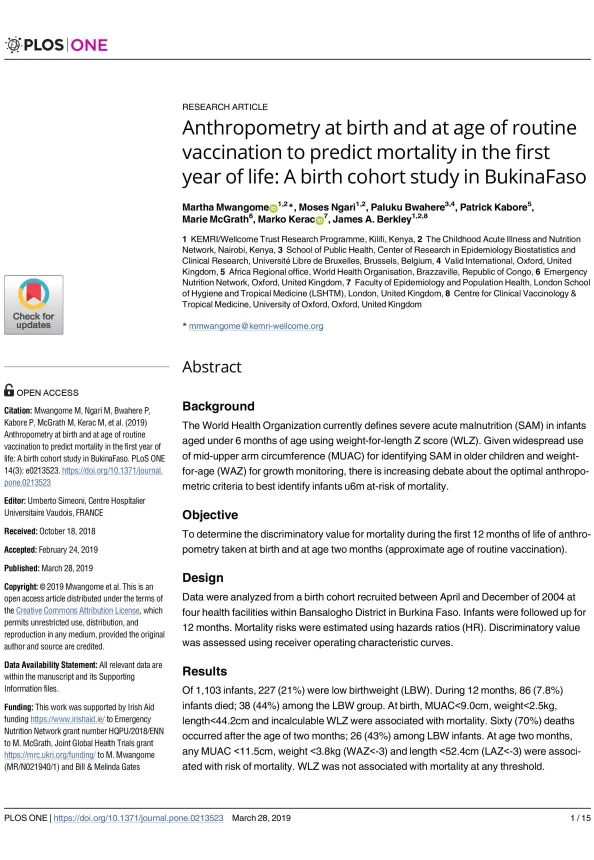Anthropometry at birth and at age of routine vaccination to predict mortality in the first year of life: A birth cohort study in Burkina Faso
Publication details
Anthropometry at birth and at age of routine vaccination to predict mortality in the first year of life: A birth cohort study in Burkina Faso
Abstract
Background
The World Health Organization currently defines severe acute malnutrition (SAM) in infants aged under 6 months of age using weight-for-length Z score (WLZ). Given widespread use of mid-upper arm circumference (MUAC) for identifying SAM in older children and weight-for-age (WAZ) for growth monitoring, there is increasing debate about the optimal anthropometric criteria to best identify infants u6m at-risk of mortality.
Objective
To determine the discriminatory value for mortality during the first 12 months of life of anthropometry taken at birth and at age two months (approximate age of routine vaccination).
Design
Data were analyzed from a birth cohort recruited between April and December of 2004 at four health facilities within Bansalogho District in Burkina Faso. Infants were followed up for 12 months. Mortality risks were estimated using hazards ratios (HR). Discriminatory value was assessed using receiver operating characteristic curves.
Results
Of 1,103 infants, 227 (21%) were low birthweight (LBW). During 12 months, 86 (7.8%) infants died; 38 (44%) among the LBW group. At birth, MUAC<9.0cm, weight<2.5kg, length<44.2cm and incalculable WLZ were associated with mortality. Sixty (70%) deaths occurred after the age of two months; 26 (43%) among LBW infants. At age two months, any MUAC <11.5cm, weight <3.8kg (WAZ<-3) and length <52.4cm (LAZ<-3) were associated with risk of mortality. WLZ was not associated with mortality at any threshold.
Birth weight did not modify the effect of the association between month two MUAC and one-year mortality (P = 0.33).
Conclusion
Infants at heightened risk of mortality and are better identified during early infancy by MUAC or WFA than by WLZ. LBW infants with low anthropometry at the age of routine immunizations remain at elevated risk than normal birth weight (NBW)infants and require intervention. Effectiveness, cost-effectiveness and coverage of applying proposed thresholds should be investigated as a priority to inform policy and practice.

